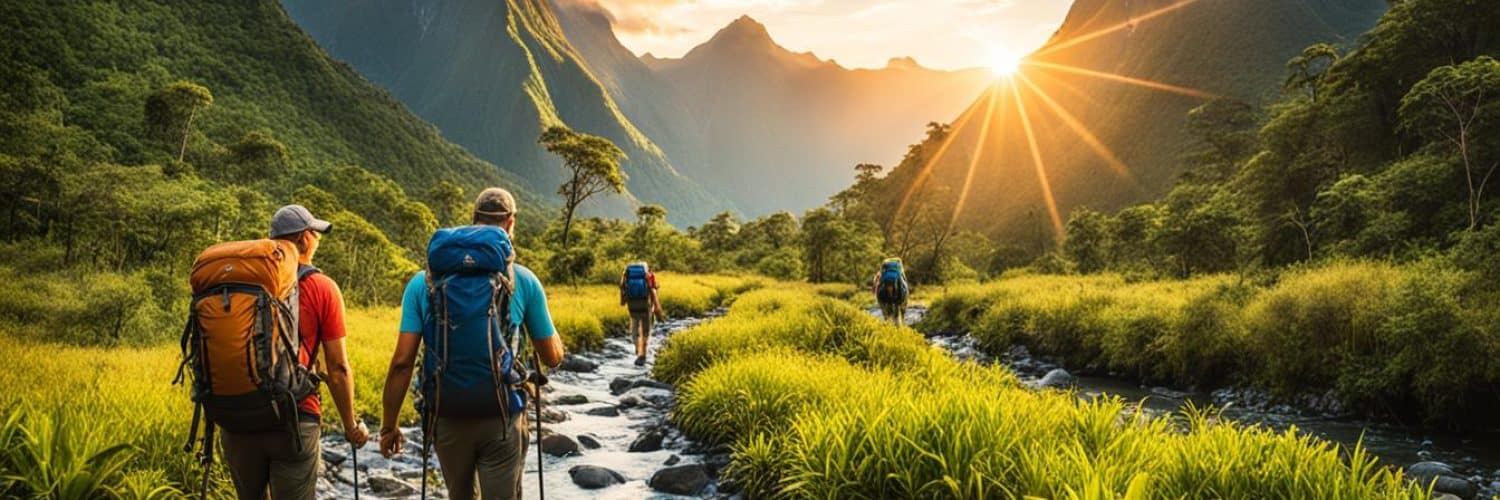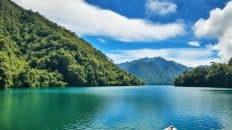Are you ready to embark on a journey to a hidden paradise nestled in the heart of Mindoro Island, Philippines? Brace yourself for an awe-inspiring adventure as we delve into the extraordinary world of Mounts Iglit-Baco National Park. Get ready to discover a biodiversity hotspot like no other and learn about the remarkable conservation efforts being undertaken to protect its critically endangered inhabitants.
Key Takeaways:
- Mounts Iglit-Baco National Park is a protected area in Mindoro, Philippines, and home to the critically endangered Tamaraw.
- The park is part of the Philippines Biodiversity Hotspot and plays a vital role in biodiversity conservation.
- Collaborative efforts between the Protected Area Management Office and the Tamaraw Conservation Program are crucial for ensuring the recovery of the Tamaraw population.
- The park’s management plan focuses on integrating the rights and cultural needs of Indigenous communities with conservation goals.
- Visitors have the opportunity to engage in activities such as Tamaraw watching, bird watching, mountain climbing, trekking, and hiking.
Get ready to be inspired as we uncover the wonders of Mounts Iglit-Baco National Park and the incredible work being done to protect its unique biodiversity. Are you ready to embark on a once-in-a-lifetime adventure? Let’s begin!
The Importance of Mounts Iglit-Baco Natural Park
Mounts Iglit-Baco Natural Park holds immense significance as one of the Key Biodiversity Areas in Mindoro. This protected area plays a critical role in the preservation and survival of unique plants, animals, and fungi that are found exclusively within its boundaries.
At the heart of Mounts Iglit-Baco Natural Park lies the Tamaraw, a critically endangered species and the park’s iconic inhabitant. However, the park’s importance extends far beyond the Tamaraw, providing a habitat for a multitude of other endangered and endemic species. These include the fascinating Ilin Island Cloudrunner, the majestic Philippine Brown Deer, the charismatic Oliver’s Warty Pig, the enchanting Mindoro Bleeding-heart Pigeon, the intriguing Mindoro Pallid Flying Fox, and the magnificent Mindoro Imperial-pigeon.
“Mounts Iglit-Baco Natural Park is a sanctuary not only for the Tamaraw, but also for a diverse array of unique and threatened species. This protected area is a treasure trove of natural wonders, contributing significantly to the planet’s biodiversity.” – Conservationist
The management of Mounts Iglit-Baco Natural Park adopts a comprehensive conservation management plan that takes into account the rights, cultural needs, and development of the Indigenous Buhid and Tau-Buid tribes. This holistic approach ensures that the conservation efforts align with the aspirations and priorities of these Indigenous communities. Additionally, the management plan focuses on ecosystem restoration and the sustainable use of the park’s resources, aiming to strike a harmonious balance between conservation and the well-being of local communities.
By safeguarding the Key Biodiversity Areas, taking into consideration the needs of Indigenous peoples, and implementing a comprehensive conservation management plan, Mounts Iglit-Baco Natural Park stands as a shining example of responsible biodiversity conservation.
Conservation Efforts at Mounts Iglit-Baco National Park
Mounts Iglit-Baco National Park benefits from the tireless conservation efforts of Re:wild, the D’Aboville Foundation, and the IUCN SSC Wild Cattle Specialist Group. These organizations are committed to protecting and restoring the park’s rich biodiversity. Working closely with the Protected Area Management Office, the Tamaraw Conservation Program, and local Indigenous peoples, their collaborative approach ensures comprehensive conservation measures.
In 2020, Re:wild was awarded the prestigious Darwin Initiative grant, which has further bolstered their conservation efforts in the park. The grant specifically supports their work with the Tau-Buid tribe, helping them gain official recognition of their ancestral domain and integrating their rights with conservation goals. This initiative plays a crucial role in recovering and restoring the shared lands of the Tamaraw and the Tau-Buid.
The conservation efforts extend beyond land preservation. Biodiversity surveys and monitoring are conducted to assess the health of the park’s ecosystems. Ranger training programs are implemented, equipping dedicated individuals with the skills needed to protect and safeguard the wildlife and habitats. Wildlife crime prevention measures are also in place to combat illegal activities that threaten the endangered species in the park.
In addition to these essential conservation initiatives, ongoing support is provided to the park’s management office and conservation program. This ensures the continuity of the work being done to safeguard the unique biodiversity of Mounts Iglit-Baco National Park.
Conservation Efforts at Mounts Iglit-Baco National Park:
| Organizations | Initiatives |
|---|---|
| Re:wild | Restoration of shared lands and biodiversity survey |
| D’Aboville Foundation | Support for Indigenous rights and preservation of ancestral domains |
| IUCN SSC Wild Cattle Specialist Group | Training programs, wildlife crime prevention, and ongoing support |
Unique Species in Mounts Iglit-Baco National Park
Mounts Iglit-Baco National Park is a sanctuary for several unique and endangered species, contributing to its biodiversity significance. Let’s explore some of the remarkable species that call this park home:
Ilin Island Cloudrunner
The Ilin Island Cloudrunner, one of the top 25 most wanted lost species, is believed to inhabit the lowland forests in and around the park. With its elusive nature, spotting this rare creature is a thrilling experience for wildlife enthusiasts.
Philippine Brown Deer
The Philippine Brown Deer, endemic to Mindoro, roams freely within the park’s boundaries. Its majestic presence and graceful movements add to the park’s natural beauty and captivating wildlife.
Oliver’s Warty Pig
Another endemic species, the Oliver’s Warty Pig, displays its distinctive appearance and playful behavior in the park’s diverse landscapes. Observing these fascinating creatures is a testament to the park’s commitment to preserving Mindoro’s unique wildlife.
Mindoro Bleeding-heart Pigeon
The Mindoro Bleeding-heart Pigeon, known for its unique heart-shaped mark on its chest, finds solace within the park’s lush forests. This species is a true symbol of the park’s dedication to protecting and sustaining the biodiversity of Mindoro.
Mindoro Pallid Flying Fox
The Mindoro Pallid Flying Fox, a large fruit bat, inhabits the park’s vibrant ecosystem. These pollinators play a crucial role in maintaining the biodiversity and ecological balance of the park.
Mindoro Imperial-pigeon
The Mindoro Imperial-pigeon, with its subtle beauty and delicate features, epitomizes the fragility and importance of the park’s conservation efforts. With a limited population size, preserving their habitat is critical for the survival of this species.
| Species | Description |
|---|---|
| Ilin Island Cloudrunner | Elusive species believed to inhabit lowland forests |
| Philippine Brown Deer | Majestic deer endemic to Mindoro |
| Oliver’s Warty Pig | Distinctive pig species displaying playful behavior |
| Mindoro Bleeding-heart Pigeon | Bird species with unique heart-shaped chest mark |
| Mindoro Pallid Flying Fox | Large fruit bat contributing to ecosystem balance |
| Mindoro Imperial-pigeon | Fragile species with limited population size |
Exploring Mounts Iglit-Baco National Park provides a rare opportunity to witness these incredible species in their natural habitats. The ongoing conservation efforts within the park play a vital role in ensuring the preservation and survival of these remarkable creatures.
“The richness of Mounts Iglit-Baco National Park’s unique species captures the essence of its commitment to biodiversity conservation and sustainability.” – Anonymous
Activities in Mounts Iglit-Baco Natural Park
Visitors to Mounts Iglit-Baco National Park have the opportunity to engage in various activities. Whether you’re a nature enthusiast or an adventure seeker, the park offers something for everyone.
Tamaraw Watching
One of the highlights of a visit to Mounts Iglit-Baco National Park is Tamaraw watching. This activity allows you to observe the critically endangered dwarf buffalo, the Tamaraw, in its natural habitat. As you journey through the park, keep your eyes peeled for glimpses of these magnificent creatures and witness their resilience in the face of adversity.
Bird Watching
If you’re a bird lover, Mounts Iglit-Baco National Park is a paradise waiting to be explored. With its diverse range of bird species, the park offers an excellent opportunity for bird watching. Grab your binoculars and camera, and get ready to spot a variety of feathered creatures amidst the park’s stunning landscapes.
Mountain Climbing
For those seeking a thrilling adventure, mountain climbing in Mounts Iglit-Baco National Park is a must-do activity. Challenge yourself as you ascend the rugged terrain, conquer peaks, and savor breathtaking panoramic views. Immerse yourself in the awe-inspiring beauty of the park’s majestic mountains.
Trekking
Embark on unforgettable treks through Mounts Iglit-Baco National Park’s diverse ecosystems. Traverse through lush forests, across rivers, and along scenic trails as you explore the park’s stunning landscapes. Discover hidden gems, encounter unique flora and fauna, and immerse yourself in the wonders of nature.
Hiking
Experience the natural wonders of Mounts Iglit-Baco National Park through hiking. With a range of trails suitable for different fitness levels, hikers can choose their adventure and explore the park’s remarkable biodiversity. From leisurely strolls to challenging hikes, there’s a trail for everyone to enjoy.
“Mountains are not stadiums where I satisfy my ambition to achieve. They are the cathedrals where I practice my religion.” – Anatoli Boukreev
Rates and Fees
When planning a visit to Mounts Iglit-Baco National Park, it’s important to be aware of the rates and fees associated with your trip. By understanding and paying these fees, you contribute to the preservation of the park’s natural treasures and support its conservation efforts. Here’s a breakdown of the various rates and fees:
Environmental Fee
Upon arrival at Mounts Iglit-Baco National Park, visitors are required to pay an Environmental Fee. This fee helps fund the park’s conservation initiatives and the maintenance of its facilities. Please note that there are different rates for locals and tourists.
Entrance Fee
Along with the Environmental Fee, there is an entrance fee to access the park. This fee ensures the continuous protection of the park’s wildlife and biodiversity.
Local Tour Guide and Porter Fee
If you prefer to have a local tour guide accompany you during your visit, there is an additional fee for their services. Local tour guides provide valuable insights into the park’s history, wildlife, and conservation efforts. Similarly, if you require the assistance of a porter to carry your belongings during activities like trekking or mountain climbing, a porter fee is applicable.
| Service | Fee |
|---|---|
| Local Tour Guide | USD XX per day |
| Porter | USD XX per day |
Use of PA Facilities
Mounts Iglit-Baco National Park offers various facilities for visitors to use, such as cottages, camping sites, picnic huts, and a multi-purpose hall. If you plan to utilize these facilities, there are corresponding fees for their use. These fees ensure the maintenance and upkeep of these amenities.
| Facility | Fee |
|---|---|
| Cottages | USD XX per day |
| Camping Sites | USD XX per night |
| Picnic Huts | USD XX per day |
| Multi-purpose Hall | USD XX per hour |
Parking Fee
If you’re planning to drive to Mounts Iglit-Baco National Park, there are parking fees for different types of vehicles. These fees contribute to the management and security of the parking areas.
| Vehicle Type | Fee |
|---|---|
| Motorcycles | USD XX per day |
| Cars | USD XX per day |
| Buses | USD XX per day |
Recreational Activities
Mounts Iglit-Baco National Park offers a range of recreational activities for visitors to enjoy, such as hiking, swimming, and trekking/mountain climbing. Each activity has specific rates associated with it. These fees contribute to the maintenance and sustainability of the park’s recreational areas.
| Activity | Fee |
|---|---|
| Hiking | USD XX per person |
| Swimming | USD XX per person |
| Trekking/Mountain Climbing | USD XX per person |
Commercial Documentation
For photography or filmmaking activities within Mounts Iglit-Baco National Park, there are commercial documentation fees. These fees support the park’s conservation efforts and contribute to the protection of its unique biodiversity.
Contact Information
For more information regarding rates, fees, and other inquiries, you can contact the Sablayan Tourism Office or Sablayan Tourist Information and Assistance Center. They will provide you with the necessary details and assist you with your visit to this remarkable national park.
Mounts Iglit-Baco National Park as an ASEAN Heritage Park
Mounts Iglit-Baco Natural Park is proud to hold the distinction of being declared as an ASEAN Heritage Park. The park’s biodiversity significance has gained recognition, making it a valuable asset to the region. The park’s domain includes the home of the Mangyans, Indigenous people who have resided in the area for generations.
Encompassing approximately 106,600 hectares, Mounts Iglit-Baco National Park is located in Sablayan, Occidental Mindoro. This recognition highlights the park’s critical role in preserving and conserving its unique flora and fauna, including the iconic Tamaraw.
| Key Points | Details |
|---|---|
| Location | Sablayan, Occidental Mindoro |
| Size | Approximately 106,600 hectares |
| Inhabitants | Mangyans, Indigenous people |
| Recognition | ASEAN Heritage Park |
As an ASEAN Heritage Park, Mounts Iglit-Baco National Park joins the esteemed list of protected areas that play a vital role in promoting environmental conservation and sustainable development in the Southeast Asian region. The park’s dedication to preserving its unique ecosystem resonates with the ASEAN’s commitment to biodiversity conservation.
Through its recognition as an ASEAN Heritage Park, Mounts Iglit-Baco National Park stands as a shining example of the importance of safeguarding our natural heritage and ensuring its long-term protection for future generations to enjoy.
Mounts Iglit-Baco National Park’s Contribution to Conservation
Mounts Iglit-Baco National Park plays a crucial role in global conservation efforts. As one of the Key Biodiversity Areas, this park is essential for preserving and protecting unique species. Penny Langhammer, the senior director for science at Global Wildlife Conservation, emphasizes the importance of effectively protecting the park to conserve the diversity of life on Earth.
The park is home to several endangered species, including the Ilin Island Cloudrunner, Philippine Brown Deer, Oliver’s Warty Pig, Mindoro Bleeding-heart Pigeon, Mindoro Pallid Flying Fox, and Mindoro Imperial-pigeon. These species make Mounts Iglit-Baco National Park globally significant for conservation.
| Endangered Species |
|---|
| Ilin Island Cloudrunner |
| Philippine Brown Deer |
| Oliver’s Warty Pig |
| Mindoro Bleeding-heart Pigeon |
| Mindoro Pallid Flying Fox |
| Mindoro Imperial-pigeon |
The Future of Mounts Iglit-Baco Natural Park
The future of Mounts Iglit-Baco National Park is focused on the implementation of a 10-year protected area management plan to ensure the long-term preservation and thriving of the Tamaraw population, as well as the conservation of other species and their habitats.
This comprehensive management plan recognizes the vital importance of partnering with the Indigenous Buhid and Tau-Buid tribes. It aims to integrate their rights, cultural needs, and traditional knowledge into the conservation efforts of the park.
The collaboration and partnership with the Indigenous communities not only contribute to the preservation of the unique biodiversity but also foster mutual respect, understanding, and harmonious coexistence between humans and nature.
As part of the ongoing conservation efforts, the Tamaraw Tales series provides valuable insights into the work being done to secure the future of the park. These initiatives raise awareness, educate the public, and encourage active participation in the conservation of Mounts Iglit-Baco National Park.
Through the implementation of the 10-year protected area management plan and the continued partnership with Indigenous people, Mounts Iglit-Baco National Park is well-positioned to thrive as a symbol of successful collaboration between conservation and cultural preservation. The park will continue to be a sanctuary for the critically endangered Tamaraw and a beacon of biodiversity conservation for future generations.
Conclusion
Mounts Iglit-Baco National Park in Mindoro, Philippines, is a true gem when it comes to biodiversity conservation. This remarkable park not only serves as a sanctuary for the critically endangered Tamaraw but also plays a vital role in preserving the unique species and habitats found within its boundaries. With collaborative efforts from organizations such as Re:wild, the D’Aboville Foundation, and the IUCN SSC Wild Cattle Specialist Group, alongside the active involvement of local Indigenous peoples, the park is successfully protected, restored, and sustainably utilized.
The management plan of Mounts Iglit-Baco National Park encompasses multiple facets of conservation. It prioritizes biodiversity preservation, ensuring the rights and needs of the Indigenous communities, and undertaking ecosystem restoration initiatives. This holistic approach ensures that the park remains a testament to the crucial importance of safeguarding natural treasures and promoting harmonious coexistence between humans and wildlife.
With its stunning landscapes and diverse ecosystems, Mounts Iglit-Baco National Park embodies the perfect harmony of nature and sustainable use. As visitors engage in activities such as Tamaraw watching, bird watching, mountain climbing, trekking, and hiking, they become witnesses to the remarkably preserved biodiversity of the Philippines. By supporting the ongoing conservation efforts and initiatives, we can secure the future of this magnificent national park and continue to celebrate its role in biodiversity conservation, Indigenous peoples’ welfare, ecosystem restoration, and sustainable use.


















Add comment